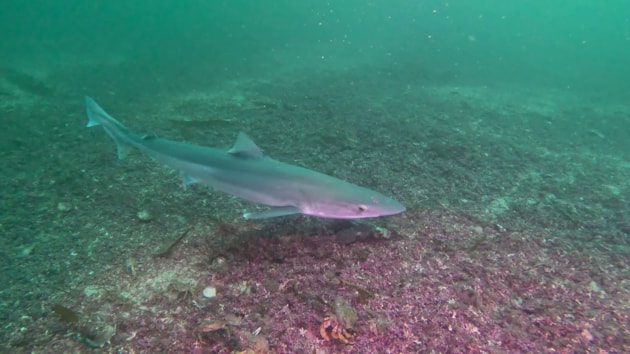31 October, 2024
Report shows distribution of Scotland’s threatened sharks, rays and skates

NOTE: links to video and pictures downloads below
New scientific research published today explores how sharks, skates and rays are distributed around Scotland’s coasts, with the results to be used to help their conservation.
Using existing information about shark, skate and ray distribution around Scotland, a report published today models where the highest numbers of nine threatened species are predicted to occur.
The report also assesses the sensitivity of sharks, skates and rays (collectively called elasmobranchs) to various fishing methods and predicts bycatch hotspots - the areas where incidental capture of elasmobranchs is most likely - in prawn and scallop fisheries. The scientists involved have predicted where the highest numbers and variety of sharks, skates and rays occur and overlaid these with the areas where bycatch is predicted to be most likely, revealing areas where conservation measures could have the greatest impact for these species.
This new evidence will support the sustainable management of fisheries and help to conserve this threatened group of fish. All species of sharks and rays are on the OSPAR list of Threatened and Declining Species.
NatureScot’s elasmobranch specialist, Dr Jane Dodd, said:
“Conserving and restoring sharks, skates and rays is difficult because we have limited information about their lives. This exciting research gives us much more insight into where the sharks, skates and rays are around Scotland’s coasts and the fishing activities they are sensitive to. We now plan to speak to fishers to learn more about their interactions with elasmobranchs.
“Research like this is vital, since all species of sharks and rays are identified as threatened and declining due to historical overfishing – and their recovery will likely be hampered by habitat damage and climate change. They depend on a healthy marine environment to ensure they have abundant prey, such as shellfish, crustaceans and fish and as top predators can act as indicators of ecosystem health.”
Elasmobranchs differ from other fish because they have a skeletal structure made from cartilage as opposed to bone. They range throughout the oceans and can be found in all oceanic and coastal zones. Scotland has over 30 species of sharks, skates and rays recorded in its waters of which 25 are found in coastal waters.
All elasmobranchs share characteristics which make them vulnerable to overfishing and their populations take a long time to recover once reduced. Elasmobranchs are slow growing, late to reach maturity and typically have low fertility, so the number of individual fish recruited into a population annually is low. Many species are also vulnerable to habitat disturbance and loss.
The research modelled the distribution of nine species by combining data from multiple sources, including experimental fishing and baited camera surveys. The species covered includes the following skates and rays: flapper skate, cuckoo ray, spotted ray, starry ray, thornback ray; and the following sharks: spurdog (also known as spiny dogfish), black mouth dogfish, lesser spotted dogfish, and starry smooth hound.
The report, led by the Scottish Government’s Marine Directorate and published by NatureScot, also found that seven out of the nine species show preferences for depths of 100m or deeper, which explains their predominance on the west of Scotland, where deep trenches can be found close inshore and within sea lochs. Species with either a preference for shallow depths, such as cuckoo rays, or no particular depth preference, such as spotted rays, were commonly found in the North Sea, to the east of Scotland.
Read the full report here.
Pictures and videos are for one-time use only in conjunction with this press release. Credit Orkney Skate Trust
Contact information
- Name
- NatureScot Media
- Telephone
- 0131 316 2655
- media@nature.scot
NatureScot is Scotland's nature agency. We work to enhance our natural environment in Scotland and inspire everyone to care more about it. Our priority is a nature-rich future for Scotland and an effective response to the climate emergency. For more information, visit our website at www.nature.scot or follow us on X at https://x.com/NatureScot
’S e NatureScot buidheann nàdair na h-Alba. Bidh sinn a’ neartachadh àrainneachd na h-Alba agus a’ brosnachadh dhaoine gu barrachd suim a chur ann an nàdar. Tha e mar phrìomhachas againn gum bi nàdar na h-Alba beairteach agus gun dèilig sinn gu h-èifeachdach le èiginn na gnàth-shìde. Tha an tuilleadh fiosrachaidh aig www.nature.scot no air X aig https://x.com/NatureScot
Downloads

Spurdog shark - one-time use only in conjunction with this press release - credit Orkney Skate Trust



